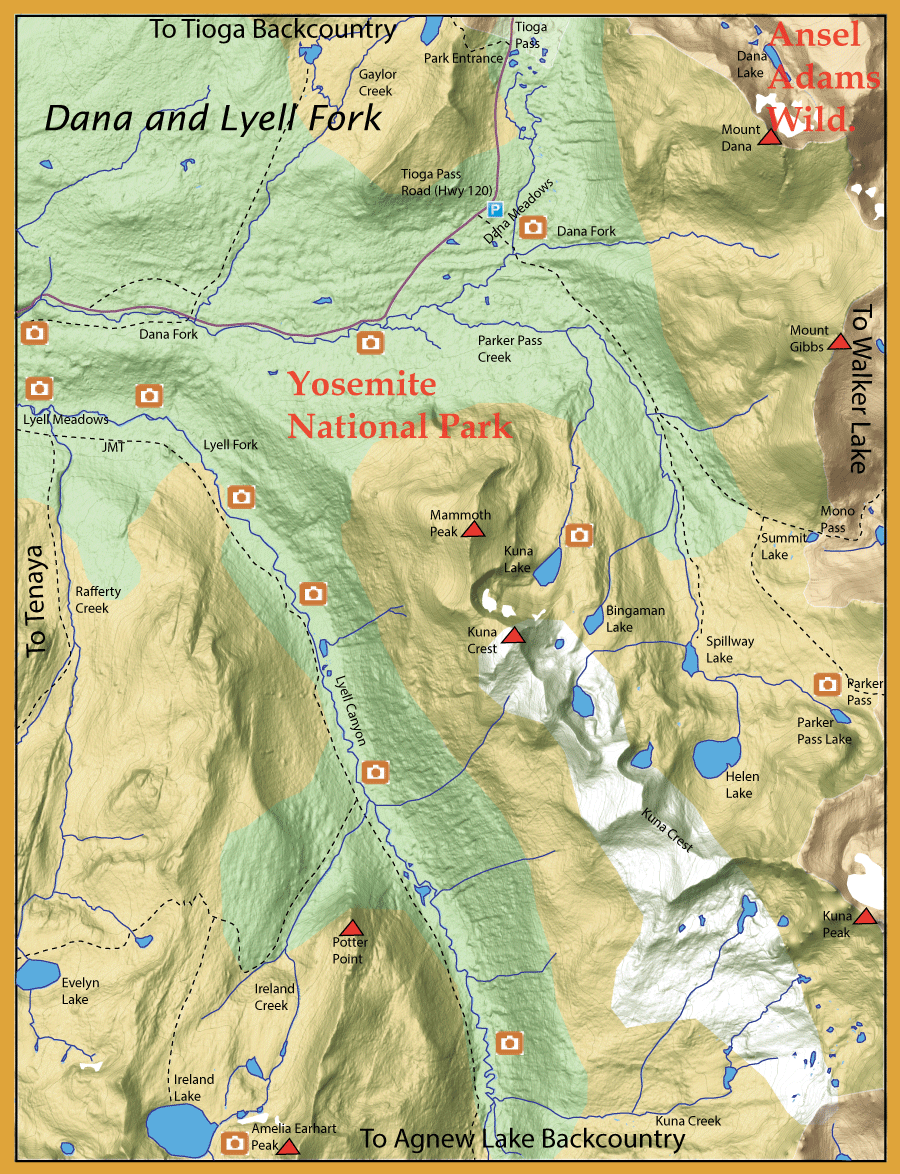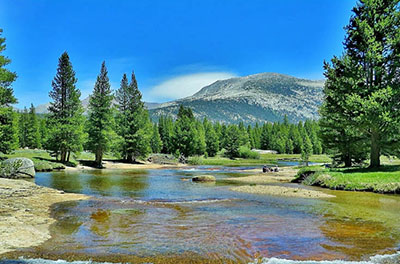Dana and Lyell Fork – along the john muir trail

 | |||
Suggested Flies for Dana and Lyell Fork area: | |||
Other Local Favorites: Wet Flies: | Dry Flies: | Nymph Flies: | |
Directions: The Dana and Lyell Forks can be reached from two directions. From the East, take Hwy 395 to Highway 120 just north of Lee Vining. This is the entrance to Yosemite by way of Tioga Pass. From the West, take Highway 120 from Manteca and becomes Tioga Road once you’ve entered the park. Highway 140 from Merced is another western entrance but you will need to go north on Big Oak Flat Road once you’ve entered the Yosemite Valley to connect to Tioga Road. From the south, you can take Highway 41 from Fresno to reach the Yosemite Valley and from there go onto to Big Oak Flat Road. | ||
Notes:
The Tuolumne splits into two forks above the meadows. Lyell ForkThe Lyell Fork follows the Pacific Crest Trail (also the John Muir Trail) for ten miles to it’s headwaters. The Lyell Fork has mainly brookies, browns, and some rainbows, with the brookies mostly in the upper reaches. Attractor drys such as Yellow Humpies and Royal Wulffs work well. A combination of a dry fly such as a Parachute Adams with a dropper such as a Zebra Midge or Pheasant Tail Nymph is excellent. It is a gentle, clear stretch of water running through meadowland. Most of the stream is 2-6 feet deep with some 20 foot deep pools. While most of the fish are 8-11 inches, there are some 12-14 inch browns that inhabit the undercut banks. Beyond the meadow section, the stream has freestone sections through numerous granite boulders forming pocket water. Stealth is critical in your presentation as the fish tend to be quite spooky. There are two places to park your car for access to the Lyell Fork. You can park at the bridge at Tuolumne Meadows and follow the John Muir trail. You will need to hike about a mile upstream as the river section is usually crowded with swimmers from the campground. The other access point is at the Wilderness Permit Center about a mile past the bridge. A trail will take you to a footbridge across the Dana Fork and onto another footbridge on the Lyell Fork. The prime fishing is upstream from this point. To VogelsandThe popular Ireland Lake trail is from the Lyell Fork up Ireland Creek. You can take a left fork and go to Ireland Lake or go straight past Evelyn Lake. This trail takes you to a High Sierra Campground called, Vogelsang, which has cabins, hot showers, and a gourmet meal. Leaving Vogelsang, you can reach Tuolumne Meadows by way of the Rafferty Creek trail. Reservations are required to stay at Vogelsang. It is 5.5 miles from Tuolumne Meadows, along Lyell Fork, to Ireland Creek. I’d suggest camping there. Next day, hike another 5 miles to Vogelsand with a 1600 feet gain. Vogelsand is at 10,300 feet. The return trip is 7 miles, downhill, along Rafferty Creek on the High Sierra Loop trail to Tuolumne Meadows. Rafferty Creek contains a healthy population of Brookies, particularly within the lower sections of the creek. Evelyn Lake: 27 acres at 10,625′ elevation. Strangely, this lake was stocked with Brookies that could not establish themselves and rainbows were able to get a foothold on the lake. The lake did not have great numbers of Rainbows but some reached 16-17″. Today, the latest reports is that the lake has a healthy population of Rainbows, 12-16 inches Ireland Lake: 77 acres at 10,725′ elevation. Contains Brookies, 8-10 inches. Dana ForkThe Dana Fork is a pocket and riffle freestone stream. It also contains browns, brookies, and rainbows, with the rainbows being more prevalent within the faster portions of the stream. Dana Fork has less water than the Lyell Fork but more fish. The fish tend to be smaller in the 6-8 inch class. It is also an excellent stretch for dry flies. Like the Lyell Fork, the fish tend to be quite spooky and you need to use stealth in your presentation. Some areas are tight with obstructions such as Lodgepole Pines and you need to use bow-and-arrow casts to present the flies to the proper areas. The granite stream bottom can be slick so rubber-soled wading boots are recommended. | ||
Fishing RegulationsDana and Lyell Fork of the Tuolumne: From the last Saturday in April through November 15, 5 trout daily bag limit, 10 trout in possession; and, from November 16 through the Friday preceding the last Saturday in April, 0 trout bag limit, artificial lures with barbless hooks only and trout must be released unharmed and not removed from the water. All Lakes and Reservoirs within Yosemite National Park: Open all year, five trout daily bag limit, 10 trout in possession. All Lakes and Reservoirs in Inyo and Mono Counties (with exceptions): Open all year, five trout daily bag limit, 10 trout in possession. All other creeks and tributaries: From the last Saturday in April through November 15, 5 trout daily bag limit, 10 trout in possession; and, from November 16 through the Friday preceding the last Saturday in April, 0 trout bag limit, artificial lures with barbless hooks only and trout must be released unharmed and not removed from the water.
| ||

